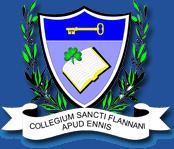Established 1846 Principal Carmel Honan Number of students 1,200 Phone +353 65 682 8019 Patron saint Flannán | President Rev. Joe McMahon Chaplain Rev. Damien Nolan Founded 1846 Staff 85 (2011) | |
 | ||
Address Clonroad More, Ennis, Co. Clare, Ireland Similar Ennis National School, Erasmus Smith House, Ennis Community College, St Caimin's Community School, Clare VEC | ||
St flannan s college the parting glass
Saint Flannan's College is an Irish co-educational secondary school located in Ennis, County Clare, which takes its name from the 7th century patron saint of the Dál gCais. Formerly an all-boys boarding school, the first girls class was entered in 2002 and in 2005 the boarding school was closed. In 2003 an extension which added over 20 new rooms to the college was completed. A measure of the expansion that has taken place over the past thirty years is that in 1962, there were some 370 pupils, 140 of whom were day boys. Only 37 teachers were in attendance. By 2004, enrollment had risen to more than 1,001 students. Staff numbers had risen to 60. In September 2002, co-ed classes were introduced in First Year. In September 2003, a new wing containing extensive new facilities was opened. In the 2010-11 school year there were 1,206 students.
Contents
- St flannan s college the parting glass
- St flannan s college ennis co clare
- History
- Sport
- Ranking
- Politics
- Television
- Academia
- References
St flannan s college ennis co clare
History
In 1846, the Diocese of Killaloe lent its prestige and patronage to the private academy conducted at Springfield House, Ennis by a Mr Fitzsimons. Fortified by diocesan support, the school would henceforth function as both a diocesan seminary and as a day and boarding school for Catholic boys. Under this arrangement, the Springfield House school flourished, and by the early 1850s was already enticing pupils away from Erasmus Smith College, College Road. Springfield pupils were conspicuously successful in obtaining scholarships to the Queen's Colleges at Galway and Cork (now NUI Galway and University College Cork). In 1859, Fitzsimons added a new wing to the college in order to cater for the increased number of students. The same year, Springfield affiliated to the newly established University of London as a preparatory college. In 1862, financial difficulties caused Fitzsimons to terminate his connection with Springfield, and under his successor the College changed directions sharply. The affiliation with the University of London was dropped for one with Newman's Catholic University in Dublin. Fitzsimons, for his part, embarked on a new career in Argentina, and within the space of a few years set up four schools. Fitzsimons died there in 1871 during an outbreak of yellow fever.
In 1865 the diocese broke with Springfield altogether and set up a diocesan college completely under its control at #12 Bindon Street, now a solicitor's office, and soon after became known as St. Flannan's Literary Institute, under a clerical headmaster, known for the first time as a president. The following year, the Institute was able to acquire the Springfield premises after the school there closed. After a comparatively short interval, a search was begun to find a site on which a larger college campus could be developed. Work finally began in 1879 on land acquired on the Limerick Road, and the College was built to a rather severe neo-Gothic design. Financial problems occasioned by the bankruptcy of the builder led to alterations in the plans, and some of the finishing touches were postponed, never to be completed. Visitors to the college are often shown such features as the plain uncarved label stops around the Gothic windows and the Clock Tower, with no clock — all now part of the fabric of College tradition.
Perhaps the most famous president of the college was Canon William Kennedy, head of St. Flannan's between 1919 and 1932. During the Anglo-Irish War, the College was a hotbed of separatist sentiment, from where the Canon personally organised the collection of the famous Dáil Loan in Clare. Still preserved in the College are letters from both Éamon de Valera and Michael Collins in connection with this undertaking. Canon Kennedy was arrested in July 1921 by British forces and interned on Bere Island. The early decades of the new state were grim as only limited funding was available for secondary education, and most costs had to be met out from the college's resources alone, but some curriculum development did take place. In 1937, for example, Physics was introduced as a subject for the Leaving Certificate, remaining for many years the only science subject available at that level.
The measure of the expansion that has taken place over the past thirty years is considerable; in 1962 there were some 370 pupils in St. Flannan's (140 of whom were day boys) and only 17 teachers. By 2004, the numbers had risen to more than 1,000 students and staff numbers had risen to 66. In September 2002, Coed classes were introduced in First Year. In September 2003, a new wing containing extensive new facilities was opened. In 2009, the College experienced very severe flooding, with much of the college grounds being submerged and water breaching the perimeter wall because of a small stream that runs underneath the college.
Sport
Students at St Flannan's are involved in a number of sports including golf, tennis, rugby, Football, the Gaelic Athletics Association, athletics and basketball. However it is at hurling that the school has had most of its success, winning a total of 21 Dr. Harty Cups (two more than its closest rival, North Monastery, County Cork) making them the most successful secondary school hurling team in Ireland.
Ranking
St Flannan's was ranked third in Ireland according to one of the most comprehensive league tables, published in The Irish Times, to date. The table was compiled by a research team at the University of Ulster and the Kemmy Business School at the University of Limerick in 2009.
